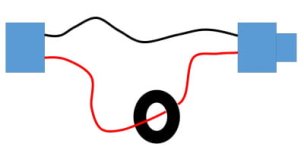john61ct said:
So how does that translate to a "50mV" shunt?
I have BMs that will accept 20A to 1000A, so long as that spec.
Larger capacity at much lower accuracy for lower currents.
A Current Shunt measures current, big, small, and everything in between.
A Current Shunt Resistor is a ( typical metal block with current passing through with two extra wires at each end, also down to the tiny resistances in pcb circuitry, known values.. ) device that puts a number (A) on a flow of current through a circuit based on known calibrations of a voltage drop (mV) through a calibrated part of the circuit, and some other voltage sensing circuitry to sense this ( calibrated ) voltage drop. This is the tried and true way of measuring the current ( v drop through calibrated chunk of metal) for a long time by now.. and typically use mV drop in the formula used to calculate the current.
A Hall effect Current Shunt is a ( what Rg is looking at, for, in a split config, so as not to cut his measured current carrying conductor and still measure) device that puts a number (A) on the current flowing through a circuit using current induced into a ring of magnetic material ( by passing through it ) ( steel) (ferrite) and measured with the output of a powered Hall Effect Sensor, which is a semiconductor device that registgers the strength and presence of a magnetic field in one direction or another.. typically read by an I/O circuit pull up or pull down on a processor. They are fast and reliable, more modern, and cheap. They dont get in the way of the current in the conductor, among other things. They are an isolated semiconductor device... used in many applications worldwide.
Two different things.
mV ( drop) = Shunt resister
0-5v (typical) = Hall Sensor output
Both measure it, and are used in design. I have seen BMS either, or, as the "main current input". The big hall sensor on the expensive and mid range EV BMS to the tiny little, appropriately sized resistors on the ebike BMS we all like.
RG might be able to" make" a Current Transformer. (CT) is a type of transformer that is used to reduce or multiply an alternating current (AC). It produces a current in its secondary which is proportional to the current in its primary.
A current transducer modifies the input on a primary conductor to a different type of signal on the secondary conductor.
https://www.digikey.com/en/article...-Umro50jnEgUk4vhJGusRVaQ2cMd-mIBoCyXcQAvD_BwE


